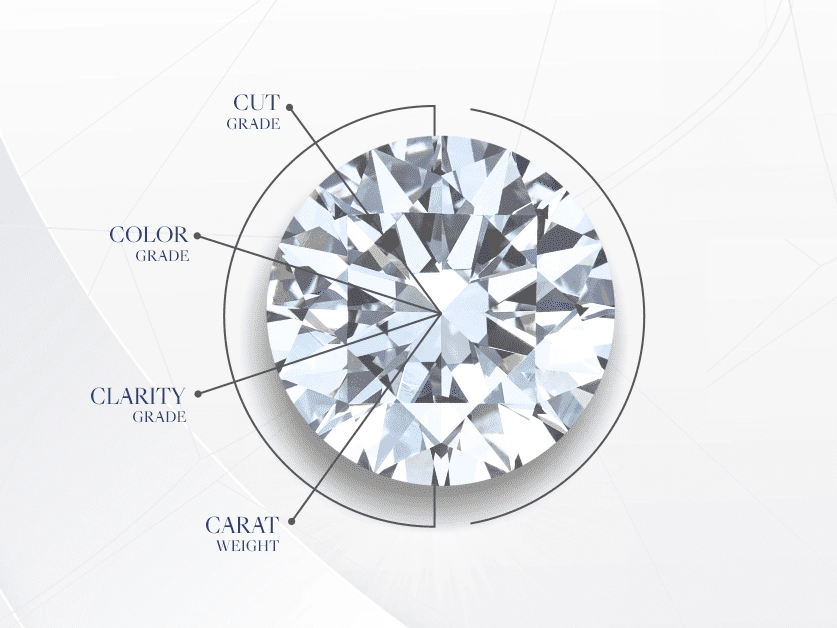MASTERING THE 4CS: A GUIDE TO SELECTING THE PERFECT DIAMOND
7th October 2024
When considering the purchase of a diamond, the intricate interplay of the “4Cs”—Cut, Clarity, Carat, and Colour—provides both the framework and language to assess its quality. Far from being mere technical markers, these four factors guide the diamond’s aesthetic beauty and determine its value. Let’s explore these elements in a deeper, more nuanced way.
Cut: The Light’s Dance Partner
The cut of a diamond is much more than its shape—it determines how light interacts with the stone, enhancing its brilliance. The proportions, symmetry, and polish of the diamond define its ability to reflect and refract light, sending it back toward the observer’s eye. Imagine the cut as the diamond’s architecture; a well-cut diamond has carefully measured facets that create a dazzling dance of light, known as the “fire” and “scintillation” that diamonds are famous for.
One common myth in the jewellery world is that diamonds set high in rings capture more light, enhancing brilliance. However, a well-cut diamond doesn’t need external light from the bottom; light entering through the crown of a finely cut diamond reflects internally and exits through the top, creating a sparkle independent of the setting. A diamond with a poor cut, regardless of its size or clarity, will lose light through the sides or bottom, appearing dull and lifeless. In essence, cut is the most significant factor in determining a diamond’s visual appeal.
Clarity: Nature’s Signature
Clarity represents the purity of the diamond’s internal structure, evaluating the presence of inclusions or surface blemishes. These natural imperfections are essentially the stone’s unique fingerprints, forged deep within the Earth. Diamonds are graded from Flawless (F) to Included (I), with multiple grades in between (such as VS for Very Slightly Included or SI for Slightly Included).
However, clarity is more about visibility than quantity. A VS2 diamond may contain inclusions invisible to the naked eye, while a larger VS diamond might reveal imperfections more easily. Interestingly, many diamonds with slight inclusions can still appear flawless without magnification, challenging the perception that only Flawless diamonds are desirable. It’s essential to recognise that beyond a certain point, clarity becomes less about performance and more about rarity and therefore, price.
Carat: The Weight of Desire
When most people think about diamonds, they focus on carat—the measure of the diamond’s weight. Carat, while significant in determining a diamond’s price, doesn’t tell the full story of a diamond’s size or beauty. Two diamonds of the same carat weight can look very different depending on their cut and proportions. For instance, a deep-cut diamond may have more weight hidden in its base, making it appear smaller than a shallower-cut diamond of the same carat weight.
Moreover, larger diamonds are rarer, which increases their value exponentially. However, this pursuit of higher carats can sometimes be at the expense of other qualities. A large diamond with a poor cut or weak clarity may not be as visually appealing as a smaller, well-cut diamond. This brings us back to the notion that carat is not a stand-alone determinant of a diamond’s beauty; it works in harmony with the other Cs.
Colour: A Spectrum of Subtlety
Diamond colour grading ranges from D (colourless) to Z (light yellow or brown), though the differences between grades can be incredibly subtle. Colourless diamonds (D-F) are considered the most desirable and rare, but near-colourless diamonds (G-J) offer a balance between beauty and affordability without compromising much in terms of appearance.
An interesting myth here is that low-colour diamonds appear whiter when set in white gold or platinum. In reality, a yellow gold setting can often help such diamonds look whiter due to the contrast. Furthermore, a diamond’s cut can influence how its colour is perceived; a well-cut diamond can mask colour better than a poorly cut one.
The 4Cs do not exist in isolation; they work together to determine a diamond’s true value and appeal. While each C plays a vital role, it’s the balance among them that creates the most captivating diamonds. An intelligently cut diamond can enhance clarity, reduce the impact of colour, and make the most of its carat weight. Conversely, an unbalanced diamond—one that sacrifices cut for size or clarity for colour—may fall short of its full potential.
When selecting a diamond, approach it as an art form rather than a checklist. The synergy of light, colour, clarity, and proportion creates a gemstone that’s more than just a commodity; it becomes a piece of timeless beauty. Embrace the 4Cs, but know that each decision is a step toward capturing a rare and brilliant part of nature’s wonder.



